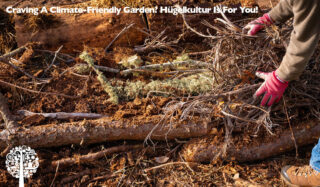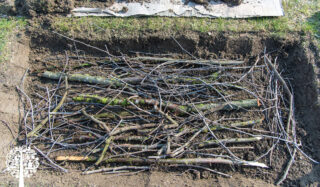Hügelkultur: A Climate-Friendly Technique | Garden Culture Magazine
The eighth principle of permaculture says that by putting things in the right place, relationships develop, and plants support each other. This concept describes the climate-friendly synchronicity of hügelkultur garden beds. The logs, branches, and other organic materials used to create this free-standing raised or sunken garden bed system work in concert with nature’s rhythms. Over time, it becomes a self-sustaining ecosystem that requires no fertilizer, compost, or irrigation and develops an enhanced ability to sequester and absorb atmospheric carbon. This gardening technique benefits the environment in three key ways.

A Microbial Carbon Sink
Microbes, such as single-cell protozoa, bacteria, fungi, and algae, live in the ground and feed on the carbon emitted by a plant’s roots and the naturally occurring organic material in the soil.
During photosynthesis, plants exhale oxygen and inhale carbon from the atmosphere, nourishing microbial life. It’s a fine-tuned balance that Mother Nature has perfected, and up until the last century, that balance kept the atmosphere free of carbon buildup.
Human-driven climate change has altered nature’s system. The carbon in the atmosphere is overshadowing the soil’s ability to scrub it clean.
As the wood and organic materials used to create hügelkultur garden beds decompose underground, the decaying organic mass encourages microbial activity, improving the soil’s ability to absorb carbon and help fight climate change.
Fertilizer A Distant Memory
Both organic and non-organic fertilizers contain nitrogen, potassium and phosphorous, the building blocks of healthy plant growth. However, inorganic fertilizer is made with chemicals like ammonia that are not good for the environment or the soil.
Even though organic fertilizers are safer, their carbon footprint is weighed against transportation, production, and packaging costs. Therefore, anytime we can eliminate fertilizer from the garden scape is a win for the climate.

In nature, ecological recycling exchanges organic and inorganic matter between living and non-living organisms. As the non-living organic matter in the hügelkultur garden slowly begins to decay, it releases nitrogen, phosphorous, and other plant-enriching nutrients back into the soil. The living roots of the crops growing in the hügelkultur bed absorb it, creating a self-fertilizing hub for healthy plant life.
Bye-Bye Hose
Scientists predict warmer temperatures, more rainfall, and less snow as climate change accelerates. Snow is a freshwater source that typically accumulates in the winter and fills local water reservoirs as it melts in spring. As snowfall and freshwater become limited, the irrigation of crops and gardens will also be restricted.
As the organic wood material used to build the hügelkultur garden decomposes, it becomes porous and acts like a sponge to absorb and retain moisture.
Over time, hügelkultur beds become self-irrigating, requiring little to no water other than average rainfall. This means that a hügelkultur bed won’t use up precious water supplies during drought.
Hügelkultur gardens work with nature’s rhythms and are the answer to climate change. They are self-containing systems that benefit plants, humans, and the environment.




